

Court & police records - Court cases in Australia - Research Guides at State Library of Victoria. Accessing judgments 'A judgment outlines the facts of the case, discusses the evidence and refers to legislation and case law upon which the judicial decision is based.
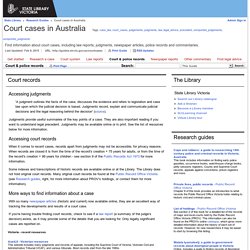
Judgments record, explain and communicate judicial decisions and the legal reasoning behind the decision' (source). Judgments provide useful summaries of the key points of a case. They are also important reading if you want to understand legal precedent. Judgments may be available online or in print. Accessing court records When it comes to recent cases, records apart from judgments may not be accessible, for privacy reasons. Some indexes and transcriptions of historic records are available online or at the Library. More ways to find information about a case With so many newspaper articles (historic and current) now available online, they are an excellent way of tracking the developments and results of a court case. Victoria - recent resources AustLII - Victorian resources CrimeNet Victoria - historic resources Book.
Website. County Court of Victoria. Supreme Court of Victoria - Supreme Court of Victoria. Magistrates' Court of Victoria. Attorney-General's Department (Australia) The Australian Attorney-General's Department is a department of the Government of Australia charged with the responsibility to serve the people of Australia by providing essential expert support to the Government in the maintenance and improvement of Australia's system of law and justice.
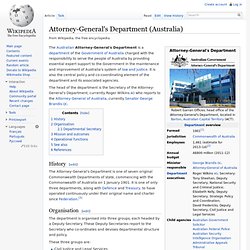
Fremantle justice complex 2001. District Court of New South Wales. The District Court of New South Wales is the intermediate court in the judicial hierarchy of the Australian state of New South Wales.
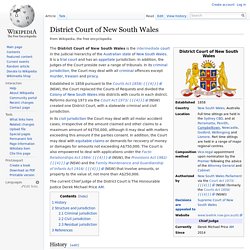
It is a trial court and has an appellate jurisdiction. In addition, the Judges of the Court preside over a range of tribunals. In its criminal jurisdiction, the Court may deal with all criminal offences except murder, treason and piracy. Established in 1858 pursuant to the Courts Act 1858/ {{{4}}} (NSW), the Court replaced the Courts of Requests and divided the Colony of New South Wales into districts with courts in each district. Reforms during 1973 via the Court Act 1973/ {{{4}}} (NSW) created one District Court, with a statewide criminal and civil jurisdiction. Trade union royal commission to run until December 2015 at cost of $8m. The Abbott government has extended the reporting date for the royal commission into trade union corruption until December 2015, at a net cost to taxpayers of around $8m.

The attorney general, George Brandis, confirmed the decision on Tuesday afternoon after a meeting of the federal cabinet in Canberra. Brandis told reporters the decision to extend the investigation by one year was based not on politics but on specific advice from Dyson Heydon. He said Heydon – the former high court judge who is presiding over the union royal commission – had told the government the inquiry would benefit from a longer reporting time and wider terms of reference. The correspondence, dated 2 October, recommends one additional term of reference, which Brandis says the government has accepted.
But it is evidently a different story in relation to findings over allegations of corrupt and illegal conduct by trade union officials. Judiciary of Australia. The judiciary in Australia is modelled substantially on the system of courts which existed in England.
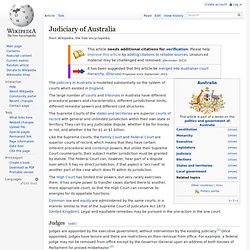
The large number of courts and tribunals in Australia have different procedural powers and characteristics, different jurisdictional limits, different remedial powers and different cost structures. The Supreme Courts of the states and territories are superior courts of record with general and unlimited jurisdiction within their own state or territory. They can try any justiciable dispute, whether it be for money or not, and whether it be for $1 or $1 billion. Like the Supreme Courts, the Family Court and Federal Court are superior courts of record, which means that they have certain inherent procedural and contempt powers.
But unlike their Supreme Court counterparts, their subject matter jurisdiction must be granted by statute. The High Court has limited trial powers, but very rarely exercises them. Judges[edit] See also[edit] References[edit] Federation - the People. Snapshot of Australia 1901. Federation Story. Federation. The Federation Kiosk, Centennial Park, Sydney at the Proclamation of Federation, 1 January 1901.

Image courtesy of the. It's hard to imagine in contemporary Australia, but prior to Federation each of the Australian colonies was more like its own country with customs houses, railway gauges and even their own military. It was neither natural nor inevitable that Australia would be federated, in fact it wasn't even a very popular idea. Only through the dedication and hard work of a small group of people did the colonies eventually come together to form a nation. Colonial politicians like Alfred Deakin, Henry Parkes and Edmund Barton waged a long campaign to turn the six colonies of 3.7 million people into a country in its own right. Teachers: Parliamentary Education Office, Parliament of Australia. Who Decides? Australian Parliment House. Parliament of Australia Search Advanced Search (ParlInfo) House is not live House of Representatives Senate is not live Senate Parliament of Australia site sections Current section pages Page tools My Parliament You are here: Education Resources Parliament: an overview gives a description of the parliamentary system.
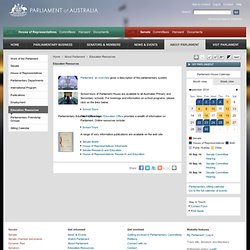
School tours of Parliament House are available to all Australian Primary and Secondary schools. Scootle- Take a vote. Becoming an Australian Citizen. Australian citizenship curriculum-linked resources for upper primary and lower secondary students.
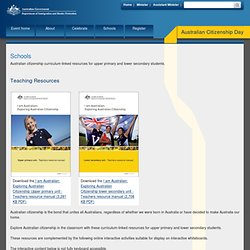
Teaching Resources Australian citizenship is the bond that unites all Australians, regardless of whether we were born in Australia or have decided to make Australia our home. Explore Australian citizenship in the classroom with these curriculum-linked resources for upper primary and lower secondary students. These resources are complemented by the following online interactive activities suitable for display on interactive whiteboards. The interactive content below is not fully keyboard accessible. Other teaching resources Promotional products Celebrate Australian Citizenship with our bunting and chatterbox templates, please click on the image or the link below each image to download: Reward students who are active and responsible citizens within your local community.
To receive an Australian Citizenship Day celebration pack, register your school event. Parliamentary Education Office.